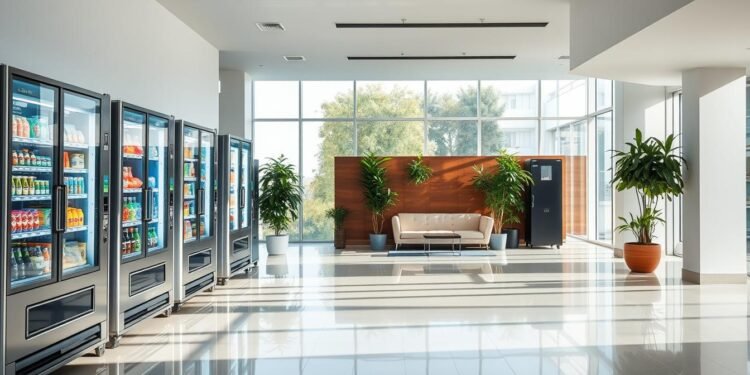Ever wondered why over 3 million automated retail units operate across the U.S.? The $8.6 billion industry continues thriving, even post-pandemic, with innovative approaches beyond soda and snacks.
Modern opportunities now include fresh meals, electronics, and even healthcare products. With 24/7 earning potential and relatively low startup costs ($2,000-$10,000), this sector attracts entrepreneurs seeking flexible income streams.
The global market reached $51.91 billion in 2021, growing at 10.7% annually. Technological advancements enable specialty vending, creating new revenue channels. Success depends on strategic location selection, maintenance planning, and understanding consumer demand patterns.
Key Takeaways
- U.S. industry generates $8.6 billion annually with steady growth
- Initial investments range from $2,000 to $10,000 for entry
- 24/7 operation capability creates passive income streams
- Technology enables vending beyond traditional products
- Location strategy remains the critical success factor
Why Start a Vending Machine Business?
The automated retail sector offers one of the most accessible entry points for entrepreneurs today. With 1.2 million units currently operating across the U.S., this industry demonstrates remarkable resilience, growing 0.4% in 2023 post-pandemic. Unlike traditional retail, automated solutions provide flexibility in operations and location-based revenue streams.
Growing Industry With Proven Demand
Market projections estimate the global sector will reach $129 billion by 2030, building on its current $8.6 billion U.S. valuation. Beverages dominate 43% of sales, but innovative products like electronics and fresh meals are expanding market share. This evolution creates opportunities beyond conventional snack distribution.
Low Barrier to Entry With High Scalability
Initial investments range from $2,000 for a single unit to $10,000 for a small fleet—significantly lower than most small business ventures. Operators typically see 15-30% profit margins, with optimized routes and product mixes achieving 50%+. Many begin with 1-5 machines before expanding to 10+ unit operations.
Automated Income Generation
Each machine averages $300 monthly revenue, requiring just 4-6 restocking visits. Top-performing locations generate over $600 with proper placement. Unlike stores needing staff, these units operate 24/7 with minimal oversight. Immediate cash flow from transactions contrasts favorably with net-30 payment terms common in retail.
Franchise models offer another pathway, with commission structures between 5-25%. Whether through ownership or partnerships, automated retail delivers consistent returns with operational efficiency that traditional businesses struggle to match.
Understanding the Vending Machine Market
Consumer preferences are reshaping the landscape of automated retail operations nationwide. The $8.6 billion industry now serves diverse needs through specialized products and technology-driven solutions. Strategic operators analyze spending patterns to maximize profitability across different locations and demographics.
Market Size and Revenue Trends
Beverages dominate 43% of total sales, with snacks accounting for 31% according to 2023 data. Specialty categories like fresh food show 18% annual growth, outpacing traditional segments. Southern states report 12% higher soda sales, while coastal regions prefer healthier drinks like kombucha (+24% year-over-year).
Key Industry Segments
Protein snacks and meal replacements now represent 19% of new installations. Offices generate 27% of total revenue, followed by schools (19%) and transit hubs (15%). Laundromats show exceptional performance with 89% attachment rates for complementary products like detergent pods.
Target Demographics and Consumer Behavior
Gen Z shoppers prefer cashless payments (68% adoption) and demand transparent nutrition information. The average transaction value sits at $2.50, with peak spending during morning and afternoon hours. Operators with 20+ units must comply with ADA accessibility standards and FDA calorie disclosure rules.
Emerging opportunities include smart refrigerators for perishable goods and micro-markets with expanded selections. Understanding these market dynamics helps operators tailor offerings to local consumer preferences while maintaining regulatory compliance.
How to Start a Vending Machine Business: Step-by-Step
Successful automated retail ventures begin with a structured approach to market analysis. A six-phase framework from IBISWorld case studies reduces risks—72% of failures trace to poor locations, per Vending Times. Each step balances research, financial planning, and operational logistics.
Step 1: Conduct Market Research
Analyze local demand using tools like SEMRush for keyword trends and Census Business Builder for demographic insights. Google Maps heatmaps reveal competitor density—aim for areas with 150+ daily visitors but fewer than three rival machines.
Prioritize market gaps: offices lacking healthy snacks or laundromats without detergent pods. Track regional preferences—coastal areas show 24% higher sales of kombucha versus soda in the South.
Step 2: Define Your Business Model
Choose between owner-operated setups (higher profits) or managed services (lower hands-on work). Calculate costs: LLCs offer liability protection, while corporations suit multi-unit expansions. Negotiate 8–12% commission rates with property business owners using foot traffic data as leverage.
Break-even typically occurs in 4–7 months. Route optimization software cuts fuel expenses by 18% for operators with 5+ machines. SBA templates simplify business plan drafting for loan applications.
Choosing Your Vending Machine Type
Equipment selection makes or breaks profitability in automated retail operations. Modern units range from basic gumball dispensers to smart refrigerators with facial recognition. The right choice depends on location demographics, maintenance capabilities, and target profit margins.
New combo vending machines cost $6,500-$10,000 but offer faster ROI through diversified sales. Refurbished units provide 30-40% savings, though they may require more frequent repairs. Top suppliers like AMS and Automated Merchandising Systems offer warranties on certified pre-owned equipment.
Food and Beverage Machines
These units dominate 74% of the market, with combo models holding 60 snacks and 120 drinks. Offices prefer healthier food options, while factories generate higher soda sales. ADA-compliant models like the Crane 167 series meet accessibility requirements.
Temperature control is critical for perishable items. Energy-efficient compressors reduce electricity costs by 18% annually. Monthly cleaning prevents mold in beverage dispensing systems.
Bulk Vending Machines
Compact units selling candy or toys deliver the fastest payback at 8 months. Quarter-operated models thrive in laundromats and arcades. Premium locations support $1.00 price points for specialty items like collectibles.
Mechanical parts require lubrication every 90 days. Anti-theft coin mechanisms prevent revenue loss. Seasonal product rotation maintains customer interest.
Specialty and Automated Retail Machines
Electronics dispensers yield 22% higher margins than traditional products. University campuses show strong demand for phone chargers and headphones. Touchscreen interfaces allow upselling through dynamic pricing.
Micro-markets need weekly inventory checks due to perishable stock. Cloud-connected units provide real-time sales data. Some states require special permits for high-value items.
Franchising Opportunities
National brands offer turnkey systems with 6-8% royalty fees. Coffee stations require 220V outlets and daily servicing. Marketing funds typically add 3% to operational costs.
Franchisees benefit from bulk purchasing power. However, territory restrictions may limit growth. Review contract terms regarding machine upgrades and location exclusivity.
Finding the Perfect Location
Strategic placement accounts for 62% of revenue variance in automated retail operations. Top-performing spots generate over $500 monthly by combining high visibility with captive audiences. The National Automatic Merchandising Association (NAMA) recommends evaluating these factors before signing any lease agreement.
High-Traffic vs. Niche Locations
Grade A locations like airports command 25% commissions but deliver $4.00/sq ft annual returns. Tier B spots in hospitals average $2.75 with steady foot traffic across all shifts. Our 5-level grading system helps operators prioritize placements:
- A: Transit hubs (300+ daily visitors)
- B: Medical facilities (200+ with 24/7 access)
- C: Office parks (150+ daytime workers)
- D: Retail stores (100+ with dwell time)
- E: Low-traffic areas (
Geo-fencing tools identify zones where conversion rates exceed 5%. Hospitals outperform office parks by 18% in snack sales, while laundromats show 89% attachment rates for complementary products.
Negotiating with Property Owners
REIT partnerships provide mall placements at $1.25/sq ft rates with 90-day exit clauses. Bring traffic analytics to negotiations—business owners accept 8-12% commissions when shown projected $300+ monthly earnings.
Red flags include locations with under 3% daily conversion rates or limited parking access. Always test sites with temporary units before signing long-term contracts.
Understanding Commission Structures
Standard brackets range from 5% for low-traffic property to 25% at premium venues. One operator improved ROI by 300% relocating from a 15% grocery store to a 10% factory breakroom with triple the footfall.
Include maintenance clauses in contracts—some landlords cover electricity for machines generating over $400 monthly profit. NAMA’s assessment guidelines help evaluate location potential objectively before committing.
Legal and Regulatory Requirements
Navigating legal requirements forms the backbone of sustainable automated retail operations. Thirty-eight states mandate specialized permits beyond standard licenses, with non-compliance fines reaching $5,000 per violation. Proper documentation protects your investment and ensures uninterrupted revenue streams.
Business Licenses and Permits
Every operator needs a sales tax ID, with food handlers permits required for perishable items in 42 states. Health department inspections occur quarterly for machines selling snacks or beverages. Costs vary significantly:
- LLC formation: $50-$500 depending on state filing fees
- Surety bonds: $1,000 minimum in 29 states
- Tobacco licenses: $300 annual fee where permitted
ADA Compliance and Safety Standards
The Americans with Disabilities Act mandates 48″ maximum height for controls and braille labeling. Front-facing units require 30″x48″ clear floor space. Non-compliant operators face lawsuits averaging $7,500 in settlement costs.
State-Specific Vending Laws
California requires calorie labels on all food units, while Texas enforces $10,000 bonds for operators with 50+ machines. Cannabis vending remains prohibited in 29 states despite local legalization. Property owners often require proof of $1 million general liability insurance before installation.
Cashless systems must meet PCI DSS standards for data security. Refrigerated units follow USDA temperature protocols with 3-hour power outage tolerances. Regular audits prevent 83% of common compliance violations.
Purchasing Your Vending Machines
Procuring the right equipment sets the foundation for long-term success in automated retail. Operators must weigh multiple factors including initial investment, maintenance requirements, and technological capabilities. Strategic purchasing decisions can reduce operational headaches while maximizing revenue potential.
New vs. Used Machines: Pros and Cons
Pre-owned units offer 30-60% savings upfront but typically have shorter 3-year depreciation cycles. New machines provide 5-year depreciation benefits and often include manufacturer warranties. Refurbishment costs for used equipment average $200-$800 per unit.
Consider your maintenance capabilities carefully. Older models may require more frequent repairs but can serve as excellent starter units. Case studies show operators building 40-unit fleets through phased acquisitions of certified pre-owned equipment.
Essential Features to Look For
Modern units should include these critical components:
- MDB protocol for universal compatibility
- NFC/cashless payment systems (used in 68% of Gen Z transactions)
- Telemetry systems improving restocking efficiency by 23%
- Energy-efficient compressors for refrigerated units
VMC compliance ensures adherence to industry standards for safety and accessibility. Units handling products requiring temperature control must meet USDA protocols.
Top Suppliers and Marketplaces
Leading manufacturers like Crane and Fuji Electric dominate the premium segment. For budget-conscious buyers, platforms like GovDeals offer auction opportunities. The National Automatic Merchandising Association (NAMA) facilitates group purchasing programs for members.
When evaluating suppliers, verify their service network coverage. Machines generating over $400 monthly profit justify premium support contracts. Export programs through the U.S. Commercial Service can help source specialized equipment internationally.
Financing Your Vending Machine Business
Financial planning separates thriving automated retail ventures from struggling startups. With average first-month costs of $3,250, strategic capital allocation determines how quickly operators reach profitability. The right mix of financing options and cash flow management can turn a modest initial investment into a six-figure enterprise.
Startup Cost Breakdown
New operators should budget for three key expense categories. Equipment purchases consume 45-60% of initial capital, with single units ranging from $1,200 for bulk models to $10,000 for smart refrigerators. Location commissions typically add 8-12% of gross sales, while inventory requires 15-20% of startup funds.
Case studies show successful operators maintain 35%+ gross margins through COGS optimization. Buying wholesale and negotiating 50% deposit terms with suppliers preserves working capital. One Texas-based operator scaled from $25,000 to $120,000 annual revenue in 18 months using this approach.

Small Business Loans and Equipment Financing
SBA 7(a) loans provide up to $5 million for qualified buyers, with 10-12% APR being standard. Equipment-specific financing offers 24-60 month terms, often requiring 10-20% down payments. Alternative options include:
Microloans from Kiva or Accion Opportunity Fund suit operators starting with 1-3 machines. Merchant cash advances at 18% APR work for quick capital but carry higher costs. Crowdfunding has launched 23 successful automated retail projects on Kickstarter since 2020.
Bootstrapping Strategies
Self-funding minimizes debt but requires disciplined budgeting. Many operators begin with refurbished equipment to reduce initial outlay. R&D tax credits can offset 10-15% of technology upgrade costs for smart machines.
Forming an LLC through IRS Form SS-4 provides liability protection without substantial fees. Route optimization software cuts fuel expenses by 18%, while telemetry systems reduce restocking trips. These tactics help preserve working capital during the critical first year.
Stocking Your Machines for Maximum Profit
Profit margins in automated retail hinge on strategic product curation and inventory control. Operators who master these elements achieve 18-40% higher returns than industry averages. Data from the Vending Market Watch shows healthy snacks deliver particularly strong performance.
Optimizing Product Selection
Top-performing items combine high turnover with solid margins. Water (16oz) at $1.50 and protein bars at $2.00 consistently rank as bestsellers. Seasonal adjustments boost revenue—summer sees 22% spikes in cold drinks sales.
Psychological pricing matters. Ending prices in .95 instead of .00 can increase conversions by 7%. Local preferences vary significantly—urban locations show 34% higher demand for organic options compared to rural areas.
Streamlining Inventory Management
Just-in-time restocking reduces waste by 15% through FIFO rotation. Smart sensors now provide real-time stock alerts, cutting out-of-stock incidents by 40%. One operator achieved a 40% sales lift by reducing SKUs from 45 to 25 top-performing products.
FDA allergen labeling requires clear disclosure of ingredients. Digital menus simplify compliance while allowing dynamic pricing. Temperature logs for perishables must be maintained for health inspections.
Wholesale Procurement Strategies
Costco Business Center and Restaurant Depot offer bulk discounts on popular candy and snacks. Local food co-ops provide 12% average savings on regional specialties. Negotiate 50% deposit terms to preserve working capital.
Building relationships with distributors ensures priority access to limited-edition items. Some operators join buying groups to access manufacturer-direct pricing. Always verify supplier track records for delivery reliability.
Setting Up and Maintaining Your Machines
Operational excellence separates profitable automated retail ventures from struggling ones. Proper installation and preventive care reduce downtime costs averaging $12/hour while extending equipment lifespan. Industry leaders report 62% better uptime through disciplined maintenance protocols.
Installation Best Practices
Successful setups begin with 20A dedicated circuits to prevent power fluctuations. Level flooring prevents 43% of mechanical jams according to NEMA 3R standards. Outdoor units require weatherproof enclosures and anti-theft anchors.
GPS trackers deter theft while providing route optimization data. Smart placement considers:
- 30″ clearance for ADA compliance
- High-traffic visibility zones
- Proximity to security cameras
Routine Maintenance Checklist
Preventive care follows this 45/90 schedule:
- Bi-monthly: Lubricate moving parts and clean bill validators
- Quarterly: Inspect sensors and refrigerant levels
- Annual: Full electrical system diagnostics
Essential tools include multimeters for voltage checks and EPA-certified refrigerant handlers. Tamper-evident seals reduce inventory shrinkage by 19%.
Vending Management Systems
Modern VMS platforms like Cantaloupe reduce service calls by 30% through:
- Real-time sales monitoring
- Predictive restocking alerts
- Remote troubleshooting
IoT sensors show 8-month payback periods by optimizing route efficiency. Cloud-based systems integrate with accounting software, saving 11 hours monthly on administrative time.
Operators using these strategies maintain 92% equipment availability versus 68% industry average. Proper care ensures your business avoids the $4,800 annual cost of neglected machines.
Marketing Your Vending Machine Business
Strategic marketing transforms automated retail units into profit-generating assets. Operators who implement modern tactics see 9-15% higher sales through enhanced visibility and customer engagement. This requires a mix of physical branding, digital tools, and partnership strategies.
Branding and Machine Customization
Full-color wraps create instant brand recognition while protecting equipment. High-impact designs require:
- 300dpi resolution for crisp graphics
- UV laminate for weather resistance
- Strategic placement of contact information
Digital menu boards deliver 200% ROI by enabling real-time promotions. Case studies show animated content increases conversions by 18% compared to static displays.
Building Relationships with Location Partners
Successful operators provide property owners with marketing kits containing:
- Foot traffic analytics reports
- Revenue share projections
- Maintenance schedules
Cross-promotions with nearby businesses boost visibility. One laundromat partnership increased detergent pod sales by 62% through co-branded discount cards.
Leveraging Technology for Customer Engagement
Mobile apps with 5% cashback programs build loyalty while collecting purchase data. SMS campaigns must comply with TCPA regulations by including opt-out instructions.
Google Business Profiles improve local discovery, driving 38% of new customer interactions. Social media ads outperform traditional methods with $0.75 CPC versus $2.50 CPM for print.
Trade shows like NAMA OneShow provide networking opportunities with suppliers and location managers. Regular customer surveys help refine product selections to match evolving preferences.
Scaling Your Vending Machine Business
Reaching 10+ units marks a turning point for automated retail operators, unlocking economies of scale and new revenue streams. Operators at this stage typically earn $75K+ annually by implementing strategic growth frameworks. Expansion requires careful evaluation of market conditions, operational capacity, and financial readiness.

Identifying Expansion Opportunities
Successful scaling begins with analyzing your current business metrics. The optimal time to expand comes when existing units maintain 1.5:1 machine-to-profit ratios consistently. Geographic information systems (GIS) help identify underserved territories with similar demographic profiles to your top-performing locations.
SCORE mentorship programs provide valuable guidance during this phase. Many operators benefit from implementing enterprise resource planning (ERP) systems before exceeding 15 units. These tools streamline inventory, maintenance, and financial tracking across multiple sites.
Strategic Growth Pathways
Adding machines to existing high-traffic sites often delivers faster returns than new location expansion. Bulk purchasing discounts kick in at 10+ unit volumes, reducing COGS by 12-18%. However, diversifying across geographic areas mitigates risk from single-point failures.
Hiring benchmarks suggest adding one full-time employee per 25 machines. Acquisition opportunities sometimes surface at 3-5x EBITDA multiples for established routes. Case studies show regional operators expanding to three counties in 18 months through this blended approach.
Diversification for Sustainable Growth
Introducing new products quarterly maintains customer interest and boosts average transaction values. Successful operators test 2-3 SKUs per category before full rollout. Micro-market conversions represent another growth avenue, increasing basket sizes by 40% in pilot programs.
Exit strategies should align with long-term goals. Employee stock ownership plans (ESOP) work for legacy operators, while strategic buyers often seek routes with standardized operations. The most successful expansions balance aggressive growth with maintained profit margins above 30%.
Conclusion
With 300 million daily transactions, this sector offers proven earning potential. NAMA data shows 83% success rates for operators who master location selection and product matching.
The right vending machine business strategy combines high-traffic spots with local preferences. Emerging tools like AI demand forecasting now help optimize inventory for maximum profit.
Remember the $8.6 billion market opportunity as you start vending. Follow these steps:
1. Form an LLC for liability protection
2. Secure prime locations with 150+ daily visitors
3. Stock machines using local sales data
4. Implement routine maintenance schedules
Industry projections show 19% growth through 2025. Many begin with two units and scale to forty-plus within three years. Download our business plan template to take your first step today.
FAQ
What are the startup costs for a vending machine business?
Initial expenses range from ,000–,000 per machine, depending on type (bulk, snack, or beverage). Additional costs include inventory, permits, and location fees.
Which locations generate the most revenue?
High-foot-traffic spots like offices, schools, and hospitals perform best. Beverage machines in gyms or snack units in factories often yield strong sales.
Do I need special licenses to operate?
Yes. Most states require a general business license. Food-handling permits may apply if selling perishable items. Check local regulations for compliance.
How often should I restock machines?
Frequency depends on sales volume. High-traffic spots may need weekly restocking, while slower locations can go 2–3 weeks. Track inventory to optimize visits.
Can I finance equipment instead of buying outright?
A> Absolutely. Many suppliers offer leasing options. Banks and SBA loans also fund equipment purchases, preserving cash for inventory and marketing.
What products sell best in vending machines?
Top sellers include bottled water, energy drinks, chips, and candy. Healthy snacks like nuts or protein bars are gaining popularity in certain markets.
How do I negotiate with property owners?
Offer 10–20% commission on sales or a flat fee. Highlight benefits like added convenience for their customers with zero overhead for them.
Are refurbished machines a good option?
Yes, if purchased from reputable dealers. Used machines cost 30–50% less than new ones. Prioritize units with cashless payment capabilities.
What’s the average profit margin?
Margins typically range 40–60% after costs. Bulk candy machines yield higher margins (70%+), while refrigerated units have lower but steadier returns.
How do I handle machine maintenance?
Clean machines monthly, check mechanics quarterly, and service coin mechanisms biannually. Many operators use route management apps to track upkeep schedules.






